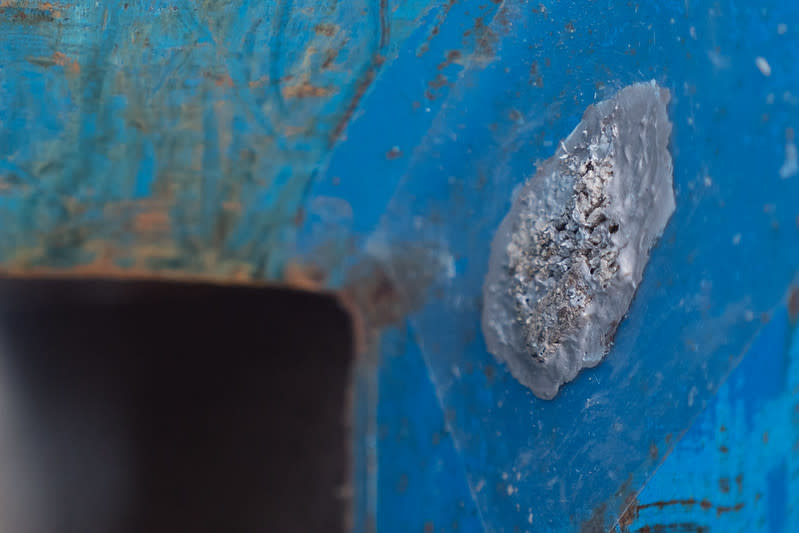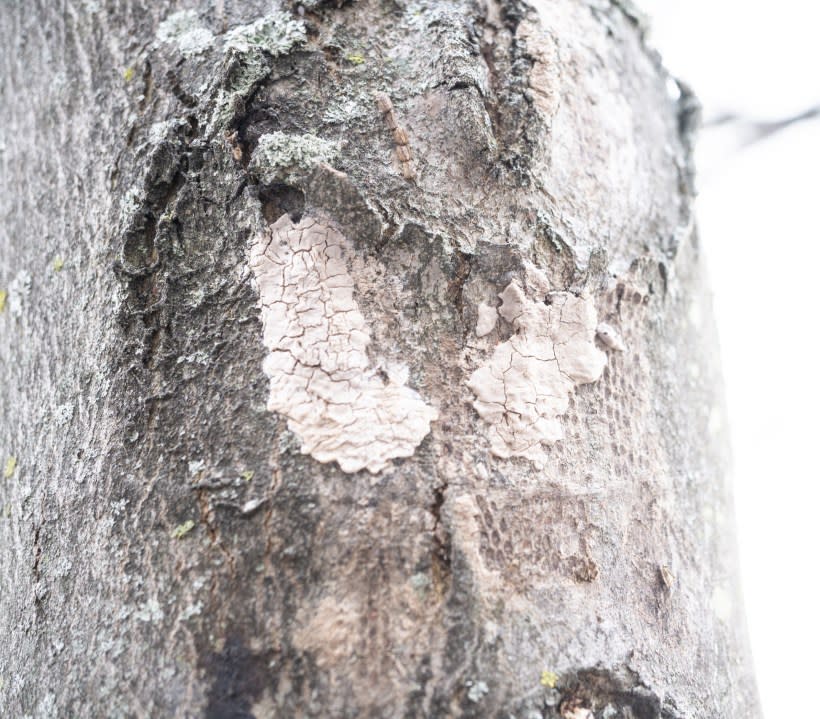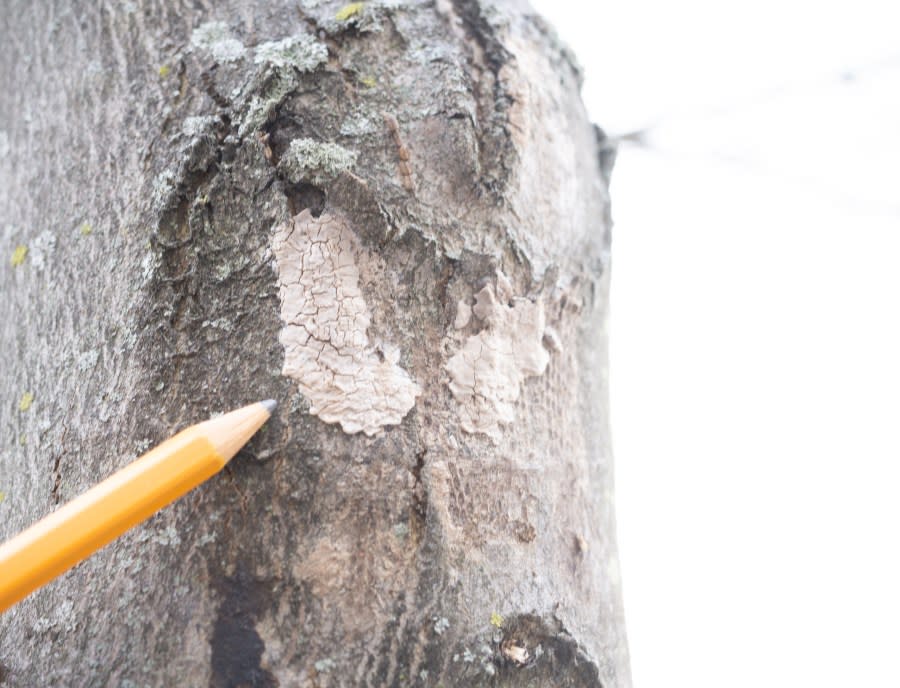Why the USDA wants you to destroy these invasive, mud-like masses

(NEXSTAR) — Now that spring has officially sprung, many species will soon be waking up or hatching. That includes a dazzling but dangerous invasive species: the spotted lanternfly.
It’s hard not to get caught up in the spotted lanternfly’s appearance. As an adult, the small insect has a set of speckled wings, part of which are red. You can see a photo of that below.
Native to China, the spotted lanternfly was first reported in the U.S. when a Pennsylvania forester noticed the bug in 2014. It has since spread to at least 16 other states, according to the U.S. Department of Agriculture: Connecticut, Delaware, Illinois, Indiana, Kentucky, Maryland, Massachusetts, Michigan, New Jersey, New York, North Carolina, Ohio, Rhode Island, Tennessee, Virginia, and West Virginia.
New to that list are Illinois, Kentucky, and Tennessee. Illinois and Tennessee confirmed their first detections in September while Kentucky recorded its first in October.

The insect feasts off of fruit, ornamental, and woody trees, targeting the sap from over 70 different plant species, PennState Extension explains. They’re able to shoot out a sap, referred to as “honeydew” by entomologists, that can coat the leaves of a plant, blocking photosynthesis and stressing the plant, Shannon Powers, press secretary for the Pennsylvania Department of Agriculture, previously explained to Nexstar. That can pose a risk to various economic aspects, including the wine industry in New York and Michigan and Christmas tree businesses in Kentucky.
The USDA considers most states at risk for spotted lanternfly infiltration, with the exception of Alaska, Iowa, Maine, Minnesota, Montana, New Hampshire, North Dakota, South Dakota, Vermont, Wisconsin, and Wyoming. Still, some of those states have warned residents to be on the lookout for the invasive species.
Can you eat a spotted lanternfly?
That includes Wisconsin, where the state’s Department of Natural Resources has encouraged residents to report sightings of the bug and one of its favorite snacks, the tree of heaven. The latter is a fellow invasive species native to China.
While officials nationwide encourage residents to stomp on adult spotted lanternflies, the invaders aren’t as easy to spot in early spring.
The spotted lanternflies are currently in their egg stage, the USDA noted earlier this month. Those appear as mud-like masses, like those seen below. They are often found on trees (like the tree of heaven) or man-made surfaces, like grills, vehicles, and outdoor machinery. Essentially, if you haven’t used any of your outdoor items since fall, you should check for the egg masses.
Businesses with pallets or dumpsters can work with state and federal agencies to remove and keep the invasive spotted lanternfly (SLF) pests from spreading by egg masses (displayed) or protected inside these containers and pallets, on August 29, 2018, in Lancaster, PA. (USDA Photo by Lance Cheung.) Close-up of Spotted Lanternfly egg mass, Berks County, Pennsylvania (Getty) Close-up of Spotted Lanternfly egg mass, Berks County, Pennsylvaniad (Getty)
If you do find a spotted lanternfly egg mass (or the insect in any other phase of its life), you should first report the sighting to state officials. The USDA has a list of state-specific reporting details. If your state is not on that list, consider reaching out to your local or state departments of agriculture or natural resources. Officials will most likely ask for any photos or videos you’ve taken of the egg mass, and encourage you not to move any wood or other possibly-infected materials.
Unless officials instruct you otherwise, once you’ve reported the sighting, you can destroy the egg masses. You’ll need to crush the masses evenly and watch for them to burst open — that’s how you know it’s been done properly. PennState Extension recommends scraping the egg mass into a bag or container of hand sanitizer or rubbing alcohol, and then disposing of the bag or container. The USDA says pressure washing has also been found to be effective in destroying the egg masses from hard surfaces.
While the egg masses may seem harmless, the spotted lanternflies become more dangerous as they age.
Spotted lanternfly: Should you be worried about them?
At best, the spotted lanternfly can only travel about a mile on its own, and that’s if it gets some help from the wind, Powers explained. Otherwise, it depends on its hitchhiking ability to move around, taking road trips on vehicles, trailers, outdoor equipment, or even hiking humans. There is no guaranteed way to keep the bug from spreading into new states and regions, but keeping it from finding a ride in the first place can help.
If allowed to spread, the spotted lanternfly “could seriously impact the country’s grape, orchard, and logging industries.” However, researchers have found a promising sign — the spotted lanternfly may not be as damaging to some hardwood trees as originally thought. Pennsylvania State University researchers recently released results of a study showing that while the spotted lanternfly will feast on native trees like the silver maple and weeping willow, reducing growth, the trees are able to recover over time.
Last year, a group of senators unveiled bipartisan legislation targeting the spread of the spotted lanternfly. The bill would provide “grants for developing and disseminating research-based tools and treatments to combat the spotted lanternfly.” Both the Senate bill and its companion in the House were referred to committees last summer.
For the latest news, weather, sports, and streaming video, head to Queen City News.



